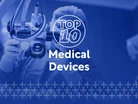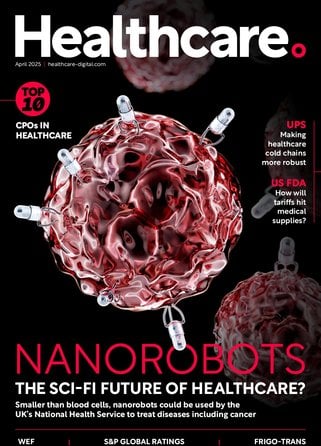Top 10: Medical Devices for Healthcare Leaders

Medical devices play a pivotal role in enhancing patient outcomes and improving the efficiency of medical practices, from life-saving technologies to everyday diagnostic tools, these ten innovations have transformed how healthcare professionals diagnose, treat and monitor patients.
This article celebrates the Top 10 medical devices that have significantly impacted the healthcare sector, highlighting their functionalities, benefits and the companies behind their development.
10. Stethoscopes
Stethoscopes - iconic symbols of healthcare professionals - are acoustic devices used to listen to internal body sounds, particularly of the heart and lungs. They remain crucial for physical examinations and initial patient assessments.
Leading manufacturers include 3M Littmann, Welch Allyn and MDF Instruments. While the basic design has changed little since its invention, modern stethoscopes incorporate advanced materials for better acoustics and electronic amplification for clearer sound. Digital stethoscopes can record and analyse sounds, aiding in telemedicine applications. Despite the advent of more advanced diagnostic tools, the stethoscope's simplicity, portability and immediacy ensure its continued relevance in medical practice, from primary care to specialist consultations.
9. Blood Pressure Monitors
Blood pressure monitors are crucial devices for diagnosing and managing hypertension, a major risk factor for cardiovascular diseases. They range from manual sphygmomanometers to fully automated digital devices. Leading manufacturers include Omron, A&D Medical and Welch Allyn.
Modern blood pressure monitors offer features like irregular heartbeat detection, multiple user memories and Bluetooth connectivity for data tracking. The widespread availability of home blood pressure monitors has empowered patients to take a more active role in managing their health.
This has led to improved hypertension control rates and reduced cardiovascular events. Recent innovations focus on wearable, continuous blood pressure monitoring technologies, which could provide more comprehensive data for personalised treatment plans.
8. Glucometers
Glucometers are portable devices used to measure blood glucose levels, essential for managing diabetes. They allow patients to monitor their blood sugar at home, enabling better disease management and reducing the risk of complications. Major manufacturers include Roche, Abbott and LifeScan. Modern glucometers offer rapid results, require smaller blood samples, and often integrate with smartphone apps for data tracking and analysis. Continuous glucose monitoring (CGM) systems have further revolutionised diabetes care, providing real-time glucose data without the need for frequent finger pricks. These advances have significantly improved glycemic control and quality of life for people with diabetes, reducing the incidence of hypoglycemic events and long-term complications.
7. Surgical Robots
Surgical robots, exemplified by the da Vinci Surgical System from Intuitive Surgical, have transformed minimally invasive surgery. These systems allow surgeons to perform complex procedures with enhanced precision, flexibility and control. They typically consist of a surgeon's console, robotic arms, and a high-definition 3D vision system. Surgical robots have been particularly impactful in urology, gynaecology and cardiac surgery, offering benefits like smaller incisions, reduced blood loss and faster recovery times.
While the da Vinci system dominates the market, other companies like Medtronic and CMR Surgical are developing competing platforms. Ongoing research focuses on haptic feedback, autonomous functions, and integration with preoperative imaging for enhanced surgical planning.
6. X-ray machines
X-ray machines use ionising radiation to create images of internal body structures, particularly useful for examining bones and detecting certain lung conditions. They remain a cornerstone of medical imaging due to their speed, relatively low cost and wide availability.
Major X-ray manufacturers include Siemens Healthineers, GE Healthcare and Philips. Modern X-ray systems have evolved to include digital detectors, reducing radiation dose and improving image quality. Portable X-ray units have become invaluable in emergency departments and for bedside imaging in hospitals. Advanced applications like dual-energy X-ray absorptiometry (DEXA) scans are crucial for diagnosing osteoporosis. Ongoing research focuses on further dose reduction and improved image processing algorithms.
5. Electrocardiogram (ECG or EKG) machines
ECG machines record the electrical activity of the heart, providing crucial information about heart rate, rhythm and potential cardiac issues. They are essential in diagnosing heart attacks, arrhythmias and other cardiac conditions. Major manufacturers include GE Healthcare, Philips, and Mindray.
Modern ECG devices range from large, multi-lead systems in hospitals to portable, even wearable, units for continuous monitoring. The integration of ECG data with electronic health records has improved long-term patient care.
Advanced algorithms now assist in interpreting ECG results, enhancing diagnostic accuracy. Recent innovations include smartphone-compatible ECG devices for personal use, potentially revolutionising early detection of heart problems in at-risk populations.
4. Pacemakers
Pacemakers are small electronic devices implanted in the chest to help control abnormal heart rhythms. They use electrical pulses to prompt the heart to beat at a normal rate, significantly improving the quality of life for patients with arrhythmias.
Major manufacturers include Medtronic, Boston Scientific and Abbott. Modern pacemakers are sophisticated, offering remote monitoring capabilities and MRI-compatible models. They have dramatically reduced mortality rates associated with certain heart conditions and allowed many patients to return to normal activities. Ongoing innovations focus on miniaturisation, longer battery life and leadless designs that can be implanted directly into the heart chamber, reducing complications associated with traditional lead wires.
3. MRI (Magnetic Resonance Imaging) machines
MRI machines use powerful magnets and radio waves to create detailed images of organs and structures within the body. They are crucial for diagnosing a wide range of conditions, from brain tumours to knee injuries, without using ionising radiation. Major manufacturers include Siemens Healthineers, GE Healthcare and Philips.
MRI technology has revolutionised medical imaging, offering unparalleled soft tissue contrast and the ability to image in any plane. Advanced techniques like functional MRI have provided new insights into brain function. Ongoing developments focus on faster scanning times, higher resolution images and more patient-friendly designs, including open MRI systems for claustrophobic patients and silent scanning technologies to reduce noise-related stress.
2. Insulin pumps
Insulin pumps are small, computerised devices that revolutionised diabetes management by mimicking the body's natural insulin delivery. They provide a continuous, adjustable supply of insulin, offering more precise control over blood glucose levels than traditional injections.
Leading manufacturers include Medtronic, Insulet and Tandem Diabetes Care. These devices have greatly improved quality of life for people with diabetes, reducing the risk of long-term complications and offering more flexibility in diet and lifestyle. Advanced models integrate with continuous glucose monitors, creating 'closed-loop' systems that automatically adjust insulin delivery. This technology has been particularly transformative for children with type 1 diabetes and their families, easing the burden of constant blood sugar management.
1. Ventilators
Ventilators assist or replace spontaneous breathing in critically ill patients. These machines deliver air and oxygen to the lungs, removing carbon dioxide in the process. During COVID-19, ventilators became crucial in treating severe cases.
Major manufacturers include Philips, Medtronic and Dräger. Modern ventilators offer various modes and settings to accommodate different patient needs, from invasive to non-invasive ventilation. They have significantly improved survival rates in intensive care units and are essential in managing respiratory failures, post-operative care and chronic respiratory conditions. Ongoing innovations focus on portability, ease of use and integration with other monitoring systems.
******
Make sure you check out the latest industry news and insights at Healthcare Digital and also sign up to our global conference series - Tech & AI LIVE 2024
******
Healthcare Digital is a BizClik brand




